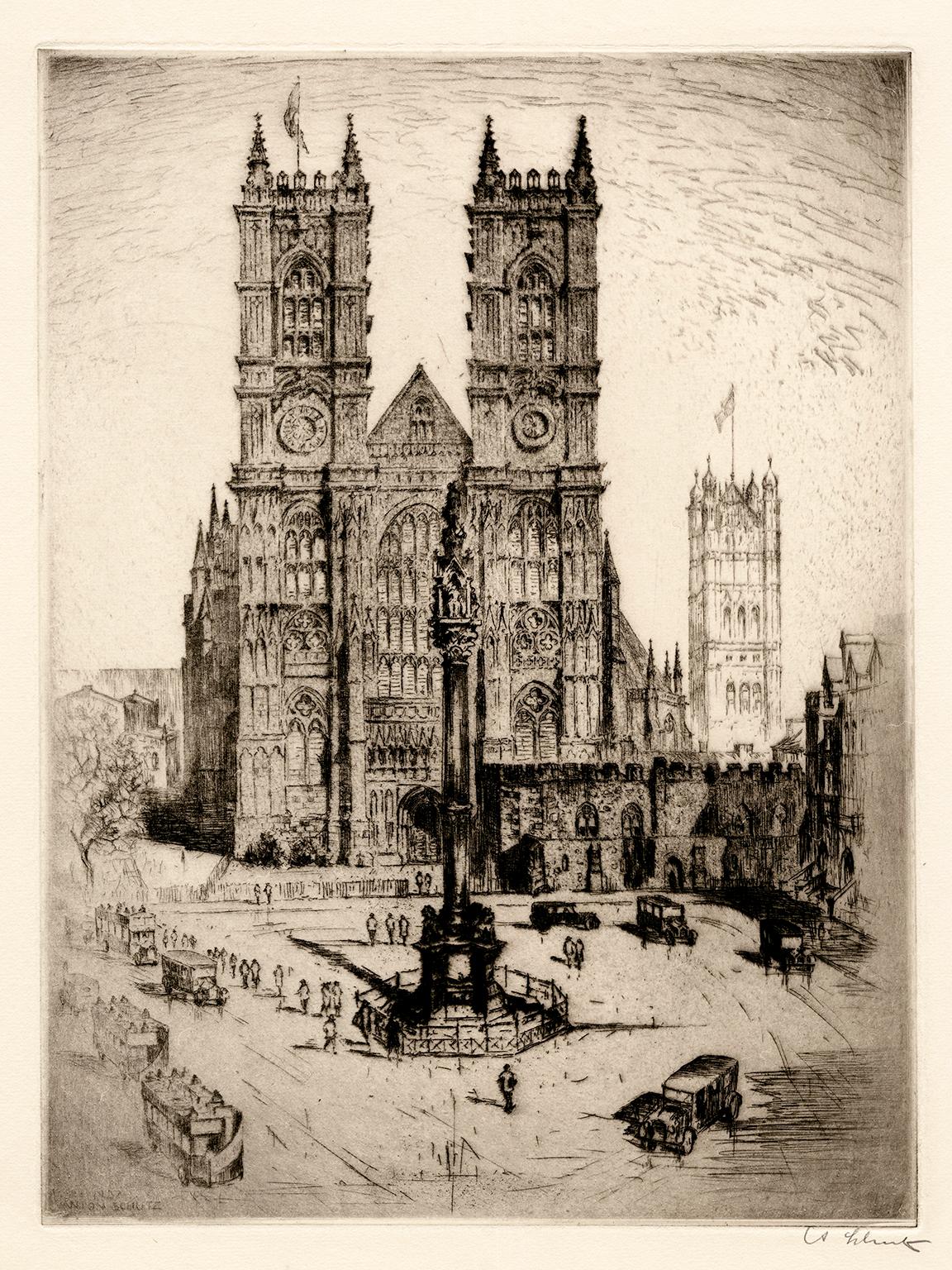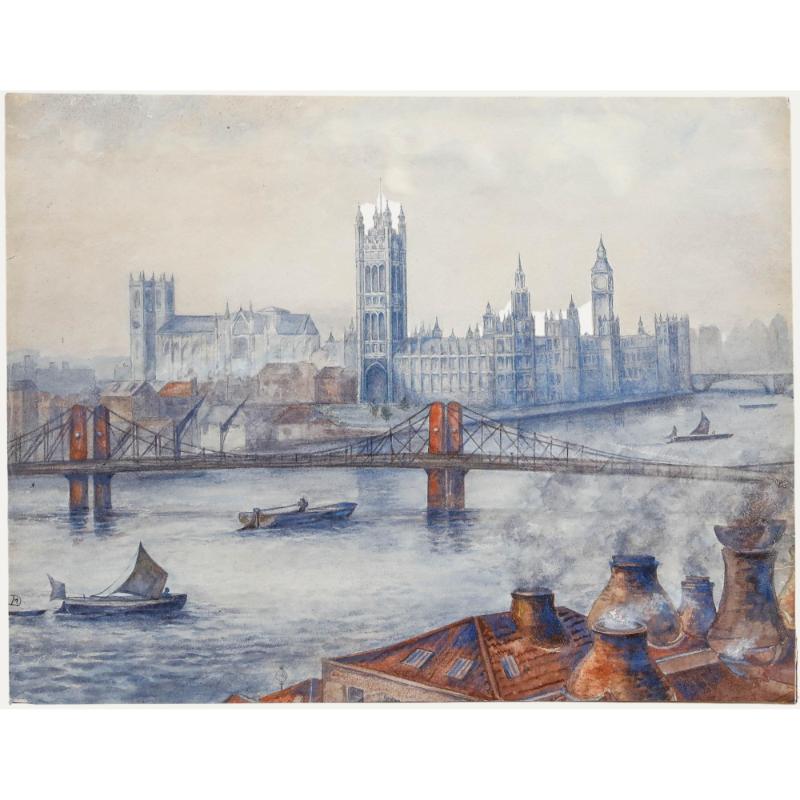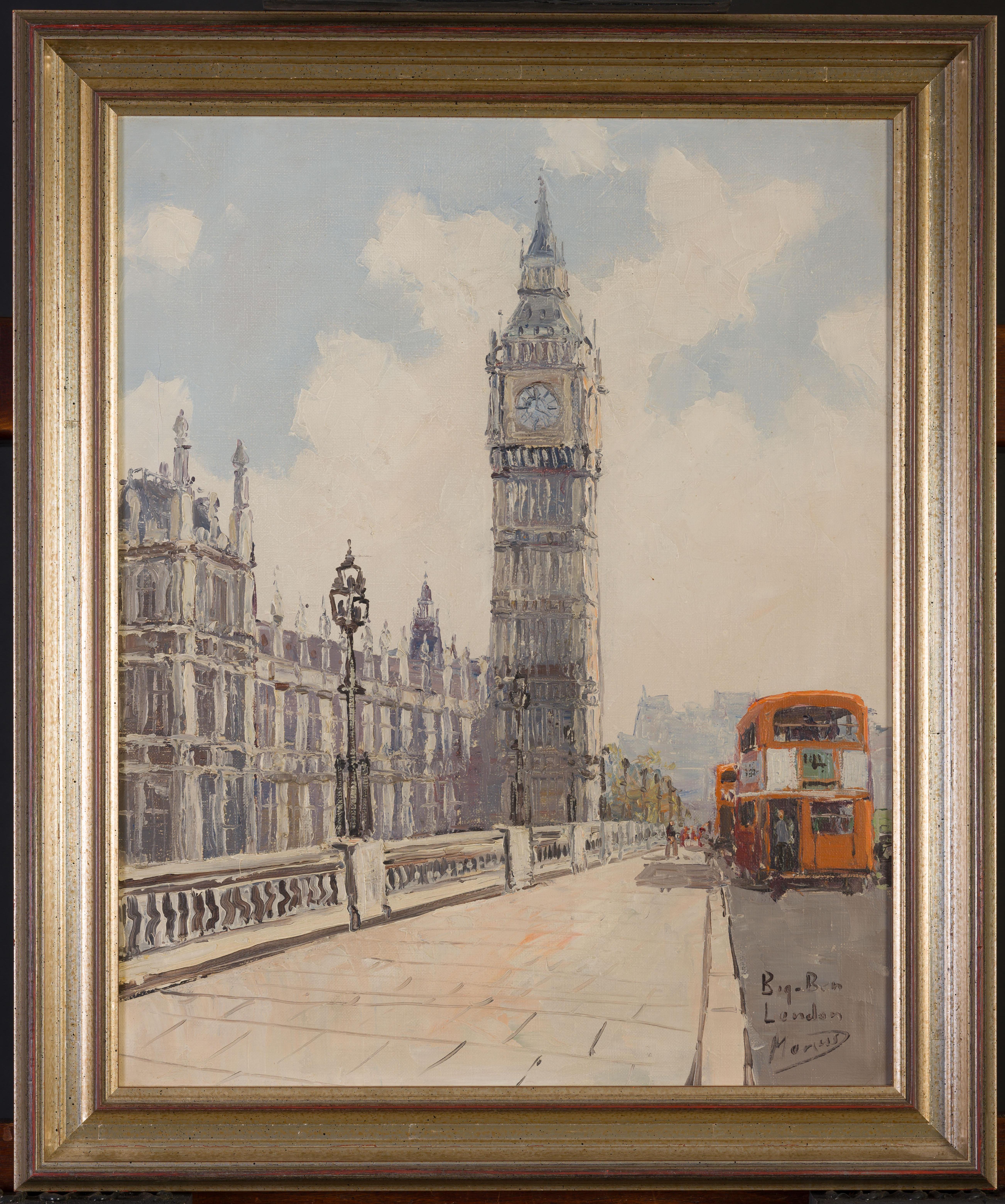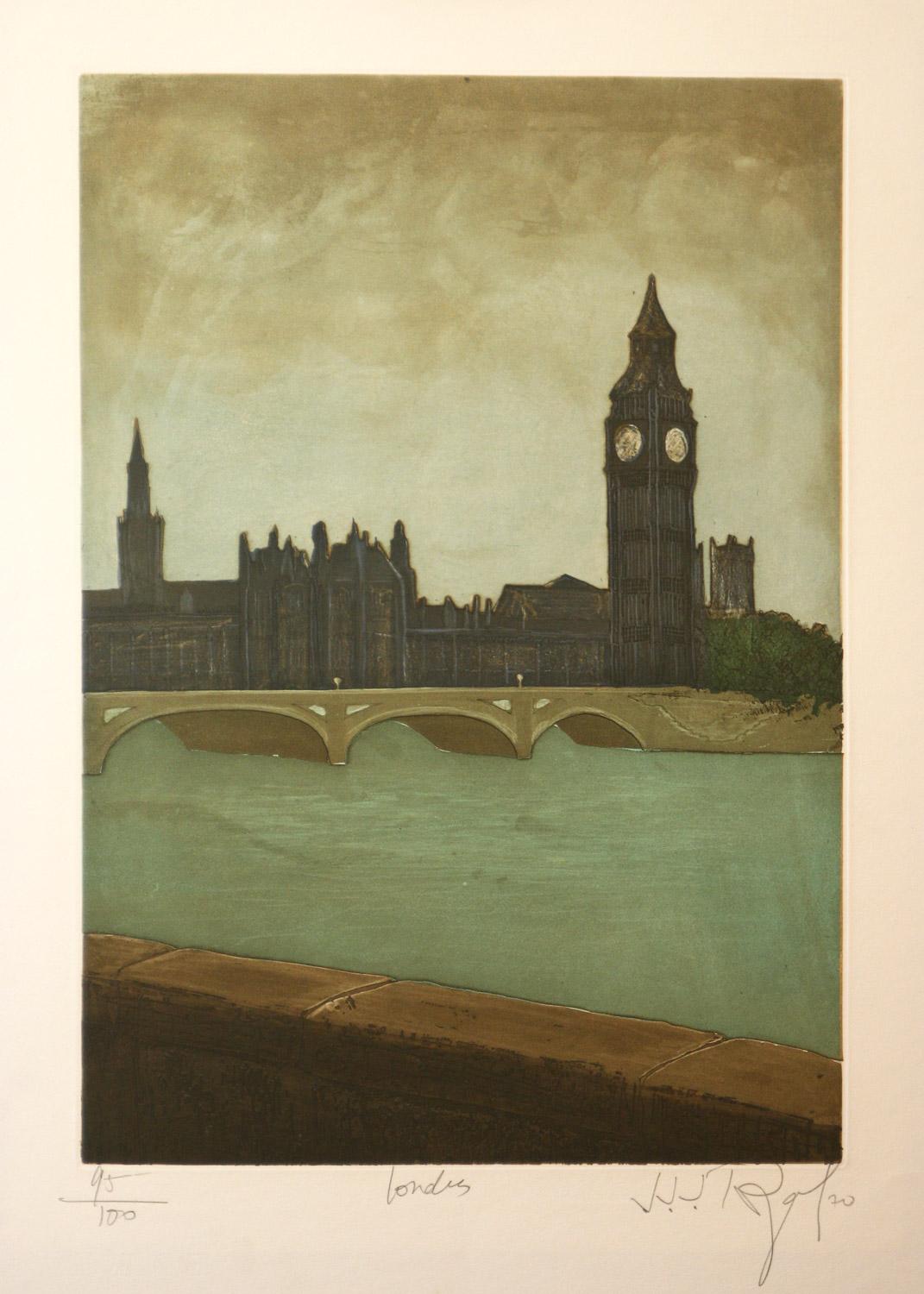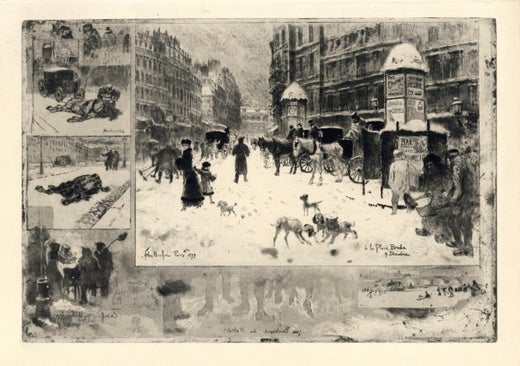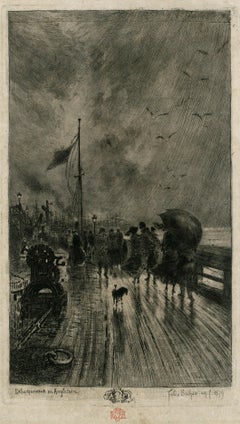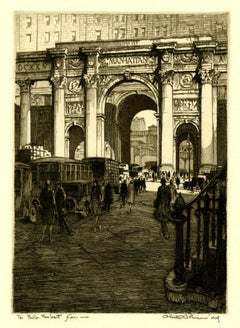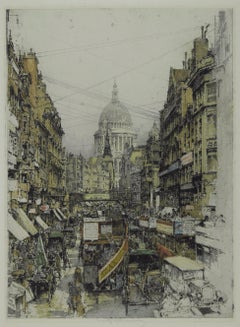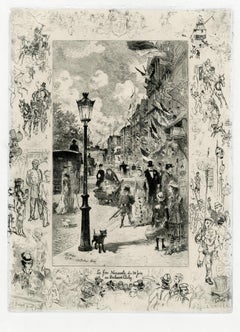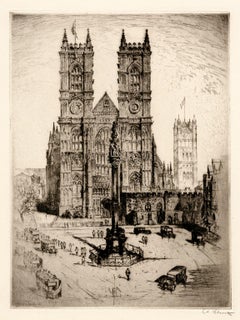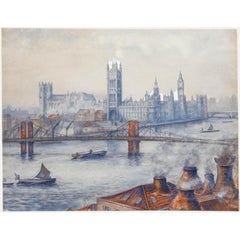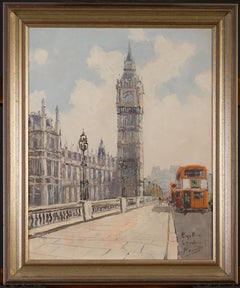Objekte ähnlich wie Westminster-Palast
Möchten Sie mehr Bilder oder Videos?
Zusätzliche Bilder oder Videos von dem*der Anbieter*in anfordern
1 von 12
Félix Hilaire BuhotWestminster-Palast1884
1884
3.072,02 €
Angaben zum Objekt
Westminster Palace
Etching, Drypoint, Aquatint, roulette and salt ground lift
1884
Depicts the Houses of Parliament, Big Ben Clock and Tower and the River Thames in the foreground.
Signed with the artist’s large Red Owl stamp, Lugt 977
Printed on thin wove japan, (almost parchment like) with full margins
A rich cleaned whipped impression showing burr in the central compositions, the remarques printing with atmospheric selective inking
This example is one of three depictions of Westminster that the artist created. One similar format etching and a vertical lithograph.
Condition: Excellent
Image/Plate Size: 11 7/16 x 15 5/8 inches
Sheet size: 14 1/4 x 18 3/4 inches
Reference: Bourcard/Goodfriend 155 vi/VIII, before the words "In pro..."
A rare proof
Impressions of this image are the collections of the following institutions:
Art Institute of Chicago
Minneapolis Institute of Art
Metropolitan Museum of Art
Van Gogh Museum
National Gallery of Art, Washington
High Museum, Atlanta
British Museum
Smart Museum, Chicago (canceled plate impression)
Achenbach Foundation of the Graphic Arts, FAMSF
Considered one of the artist's finest images.
Félix-Hilaire Buhot
French, 1847 - 1898
Among the most original prints made in France during the last quarter of the nineteenth century are those by Félix Buhot. Born in 1847 in the small Normandy town of Valognes, in northern France, Buhot moved to Paris in 1865, where a year later he enrolled in the École des Beaux-Arts, studying painting and drawing under various artists. Buhot first learned to etch in about 1873, producing his first etching later that year and quickly establishing himself as a successful printmaker. The young artist made his living by decorating fans and illustrating lithographic sheet music. Buhot lived and worked most of his life in Paris, with frequent visits back to northern France and extended trips to England where he met his wife, Henrietta Johnston, whom he married in 1881. By 1892 Buhot had ceased making prints, and in 1898, after suffering prolonged bouts of deep depression, he died at the age of fifty-one.
Along with Edgar Degas and Camille Pissarro, Félix Buhot numbers among the most experimental printmakers of his day. In exploring the unique aspects of etching, he developed an approach to printmaking that was very painterly; in fact he called his prints "paintings on copper." A true printmaker's printmaker, Buhot delighted in all the technical variables and regularly combined multiple processes to produce a single print: he achieved even greater tonal variation by employing the more traditional techniques of etching, drypoint, and aquatint along with several less familiar methods. Unlike many contemporary printmakers who disliked photography, Buhot heartily embraced the medium and used it as a creative aid. He also used different inks and papers for varied effects. His most original contribution to the history of printmaking is a device he termed marges symphoniques (symphonic margins): by amplifying the main subject, such illustrations became an integral part of the print.
In his many prints of city views and seascapes, Buhot was intent on creating a specific atmosphere, especially the effects of weather such as rain, snow, mist, and fog. He turned to his immediate neighborhood in and around the boulevard de Clichy in Montmartre, Paris, for inspiration for his prints of everyday city life. Buhot delighted in portraying the varied street life of the vibrant capital city not only in different seasons (Winter in Paris, 1879) but also in moments of public display, from a festive holiday celebration (National Holiday on the Boulevard de Clichy, 1878) to a somber death observance (Funeral Procession on the Boulevard de Clichy, 1887). His city views also include London scenes (Westminster Palace and Westminster Bridge, both of 1884). And Buhot's love for the sea is evidenced in the many prints exploring its ever-changing atmospheric conditions and moods. Buhot's boat trips to England inspired two of his most characteristic prints, A Pier in England and Landing in England, both from 1879.
With his experimental printmaking techniques, Buhot became one of the best-known, admired, and collected printmakers of his day. He achieved success for his prints at the annual Salons between 1875 and 1886, and a number of his works were published in leading periodicals and books. He also found critical acclaim and support for his prints in the United States, especially after his first one-man exhibition organized by the New York print dealer Frederick Keppel in 1888.
Courtesy: National Gallery of Art, Washington, D. C.
- Schöpfer*in:Félix Hilaire Buhot (1847 - 1898, Französisch)
- Entstehungsjahr:1884
- Maße:Höhe: 29,11 cm (11,46 in)Breite: 39,71 cm (15,63 in)
- Medium:
- Bewegung und Stil:
- Zeitalter:
- Zustand:
- Galeriestandort:Fairlawn, OH
- Referenznummer:Anbieter*in: FA111551stDibs: LU14014196842
Félix Hilaire Buhot
Buhots Drucke entstanden in einer Zeit, in der das Interesse an der Originalgrafik (insbesondere an der Radierung) wieder auflebte, die sich gegenüber dem reproduktiven Kupferstich schnell durchsetzte. Seine Radierungen wurden bereits 1874 von dem herausragenden Kritiker Philippe Burty gelobt, der die "belles épreuves" (schöne Abzüge) des Künstlers bewunderte - ein Begriff, den Burty als Bezeichnung für seltene, vom Künstler selbst gedruckte Abzüge mit hervorragender Tusche verwendete. In den 1880er Jahren war Buhot zu einem der bekanntesten und meistgesuchten Grafiker seiner Zeit geworden. Buhot war weit über die Grenzen seines Landes hinaus bekannt, und auch in den Vereinigten Staaten erntete er viel Lob und Unterstützung für seine Drucke. Der New Yorker Graphikhändler Frederick Keppel (1845-1912) gab Buhot 1888 seine erste Einzelausstellung, die recht erfolgreich war. Neben Keppel befreundete sich Buhot mit zwei prominenten amerikanischen Sammlern des späten neunzehnten Jahrhunderts, die eine große Anzahl von Grafiken des Künstlers sammelten: Samuel P. Avery (1822-1904) aus New York sammelte über 300 Grafiken und George A. Lucas (1824-1909) aus Baltimore besaß etwa 200 Grafiken. Ab 1911 wurde eine weitere große Sammlung von Albert H. Wiggin (1868-1951) aus Boston aufgebaut, der über 150 Abdrücke kaufte. Heute befinden sich diese Sammlungen in der New York Public Library, dem Baltimore Museum of Art und der Boston Public Library.
Anbieterinformationen
5,0
Anerkannte Anbieter*innen
Diese renommierten Anbieter*innen sind führend in der Branche und repräsentieren die höchste Klasse in Sachen Qualität und Design.
Platin-Anbieter*in
Premium-Anbieter*innen mit einer Bewertung über 4,7 und 24 Stunden Reaktionszeit
Gründungsjahr 1978
1stDibs-Anbieter*in seit 2013
815 Verkäufe auf 1stDibs
Typische Antwortzeit: <1 Stunde
Verbände
International Fine Print Dealers Association
- VersandAngebot wird abgerufen …Versand von: Akron, OH
- Rückgabebedingungen
Einige Inhalte dieser Seite wurden automatisch übersetzt. Daher kann 1stDibs nicht die Richtigkeit der Übersetzungen garantieren. Englisch ist die Standardsprache dieser Website.
Authentizitätsgarantie
Im unwahrscheinlichen Fall eines Problems mit der Echtheit eines Objekts kontaktieren Sie uns bitte innerhalb von 1 Jahr für eine volle Rückerstattung. DetailsGeld-Zurück-Garantie
Wenn Ihr Objekt nicht der Beschreibung entspricht, beim Transport beschädigt wurde oder nicht ankommt, kontaktieren Sie uns bitte innerhalb von 7 Tagen für eine vollständige Rückerstattung. DetailsStornierung innerhalb von 24 Stunden
Sie können Ihren Kauf jederzeit innerhalb von 24 Stunden stornieren, ohne jegliche Gründe dafür angeben zu müssen.Geprüfte Anbieter*innen
Unsere Anbieter*innen unterliegen strengen Dienstleistungs- und Qualitätsstandards, wodurch wir die Seriosität unserer Angebote gewährleisten können.Preisgarantie
Wenn Sie feststellen, dass ein*e Anbieter*in dasselbe Objekt anderswo zu einem niedrigeren Preis anbietet, werden wir den Preis entsprechend anpassen.Zuverlässige weltweite Lieferung
Unsere erstklassigen Versandunternehmen bieten spezielle Versandoptionen weltweit, einschließlich individueller Lieferung.Mehr von diesem*dieser Anbieter*in
Alle anzeigenUn Debarquement en Angleterre (Einmbarken in England)
Von Félix Hilaire Buhot
Un Debarquement en Angleterre
(A Ausschiffung in England)
Radierung, Kaltnadel, Aquatinta, Roulette und Spiritusgrund, 1879
Signiert mit dem roten Eulenstempel des Künstlers, Lugt 97...
Kategorie
1870er, Impressionismus, Landschaftsdrucke
Materialien
Kaltnadelradierung
Das Stadtgebäude von Manhattan
Von Chester B. Price
Unten rechts mit Bleistift signiert und mit "imp" vermerkt; unten links mit Widmung: "To Bob Nisbet from..."
Anmerkung: Das von William M. Kendall von McKim, Mead und White entwor...
Kategorie
1910er, Landschaftsdrucke
Materialien
Kaltnadelradierung
Fleet Street, London
Von Luigi Kasimir
Fleet Street, London
Radierung mit weichem Grund und Aquatinta, um 1936
Vom Künstler mit Bleistift signiert (siehe Foto)
Zustand: Sehr guter Zustand mit braunem Papierklebeband an de...
Kategorie
1930er, Landschaftsdrucke
Materialien
Radierung, Holzschnitt
Nationalfeiertag auf dem Boulevard Clichy
Von Félix Hilaire Buhot
Nationalfeiertag auf dem Boulevard Clichy
Radierung, Kaltnadel und Aquatinta, 1878
Signiert unten links in der Platte (siehe Foto)
Gedrucktes Chine-College, auf weißes Velin aufgezog...
Kategorie
1870er, Französische Schule, Figurative Drucke
Materialien
Radierung
Palazzo, Florenz
Von Rudy O. Pozzatti
Palazzo, Florenz
Radierung, Kupferstich, Aquatinta, Weichgrund und Hebegrund, Farbdruck von drei Kupferplatten. 1954
Signiert mit Bleistift unten rechts (siehe Foto)
Auflage 250 plis...
Kategorie
1950er, Amerikanische Moderne, Landschaftsdrucke
Materialien
Aquatinta
Der Duomo, Florenz
Von Donald Shaw MacLaughlan
Der Duomo, Florenz
Aquarell, 1914
Signiert und datiert unten in der Mitte (siehe Foto)
Die Kathedrale von Florenz, offiziell die Cattedrale di Santa Maria del Fiore, ist die Kathedr...
Kategorie
1910er, Amerikanische Moderne, Landschaftszeichnungen und -aquarelle
Materialien
Wasserfarbe
Das könnte Ihnen auch gefallen
Westminster-Palast
Von Félix Hilaire Buhot
Felix Buhot (1847-1898), Westminster Palace, Radierung, Kaltnadel, Roulette, 1884, mit Bleistift signiert und mit zahlreichen Anmerkungen versehen. Bourcard/Goodfriend 155, Bourcards...
Kategorie
1880er, Impressionismus, Landschaftsdrucke
Materialien
Kaltnadelradierung, Radierung
Westminster Abbey" - Königliche Kirche, London
Von Anton Schutz
Anton Schutz, "Westminster Abbey", Radierung, Auflage nicht angegeben, 1927. Mit Bleistift signiert. Signiert und datiert in der Platte unten links. Ein hervorragender, reich getusch...
Kategorie
1920er, Amerikanischer Realismus, Landschaftsdrucke
Materialien
Radierung
Aquarell aus dem frühen 20. Jahrhundert - Der Palast von Westminster
Ein charmanter Blick auf Westminster an der Themse an einem nebligen Morgen. Signiert mit einem Monogramm unten links. Auf dem Papier.
Kategorie
20. Jahrhundert, Landschaftszeichnungen und -aquarelle
Materialien
Wasserfarbe
Big Ben, Westminster, London. 1970's
Morris oder Morius, ein unbekannter Maler, der eine Vorliebe für extravagante, kavalierhafte Pinselführung hat, offensichtlich ein sehr erfahrener und selbstbewusster Künstler, der ...
Kategorie
1970er, Landschaftsgemälde
Materialien
Öl, Karton
London, England, Original signierte Original-Aquatinta-Radierung von J.J. Regal
London, England ist eine original signierte Aquatinta in limitierter Auflage Radierung des französischen Künstlers J.J. Regal gedruckt auf BFK Rives Papier. Dies ist ein sehr ge...
Kategorie
20. Jahrhundert, Expressionismus, Landschaftsdrucke
Materialien
Radierung
Aquarell aus der Mitte des 20. Jahrhunderts – Houses of Parliament vom Whitehall Court
Ein charmanter Blick auf die Houses of Parliament vom Whitehall Court in der Abenddämmerung. Unten rechts mit Ortsangabe beschriftet. Unleserlich beschriftet mit Signatur. Präsentier...
Kategorie
20. Jahrhundert, Landschaftszeichnungen und -aquarelle
Materialien
Wasserfarbe
214 € Angebotspreis
20 % Rabatt
